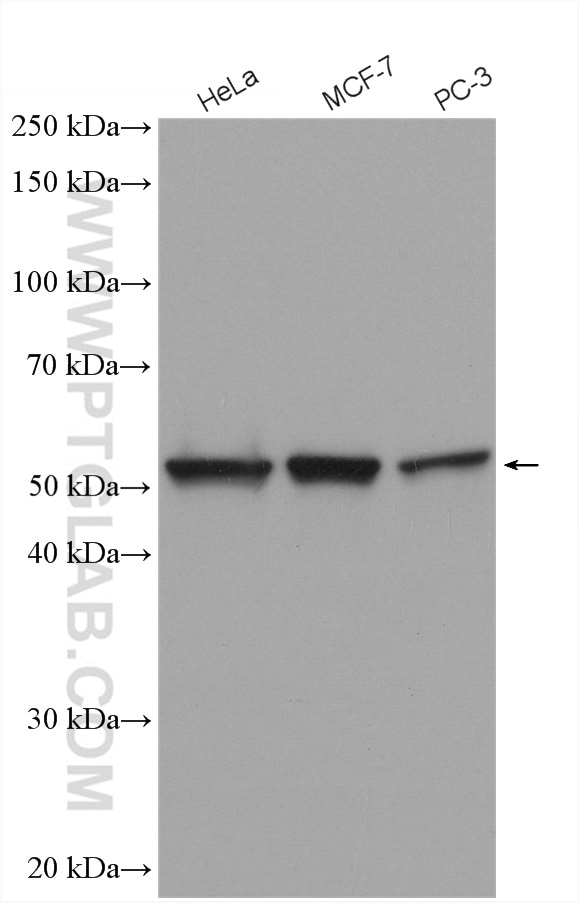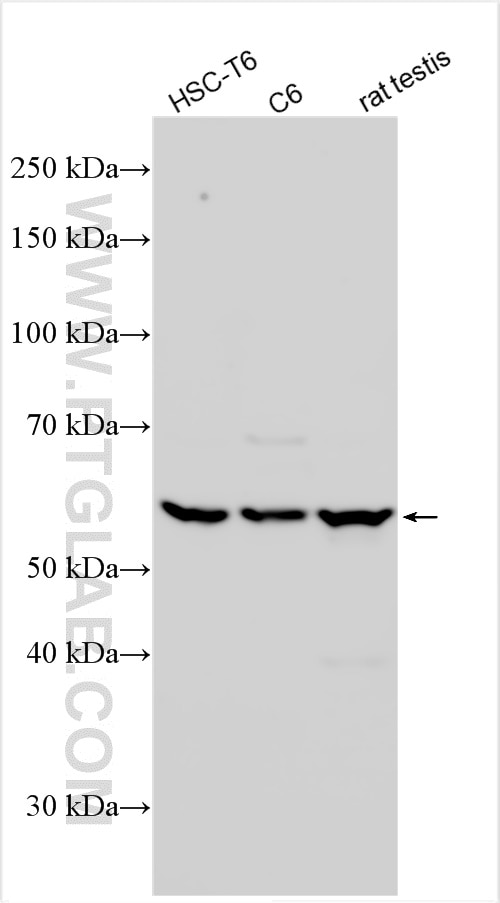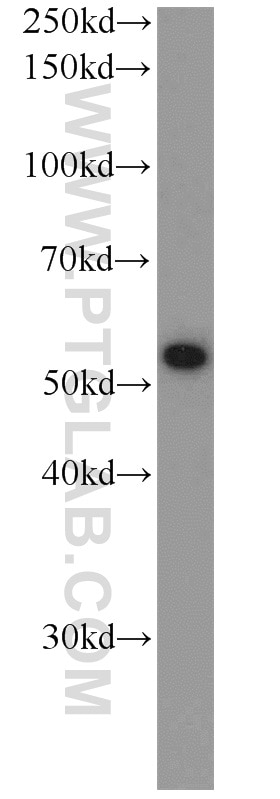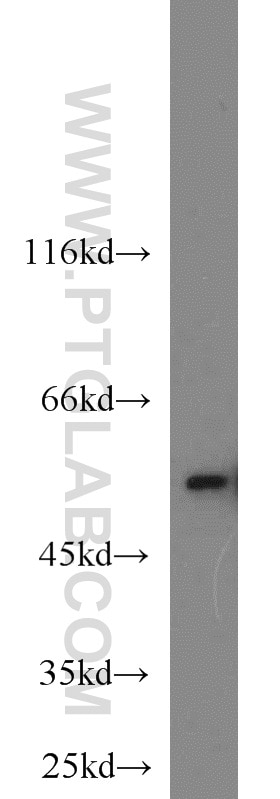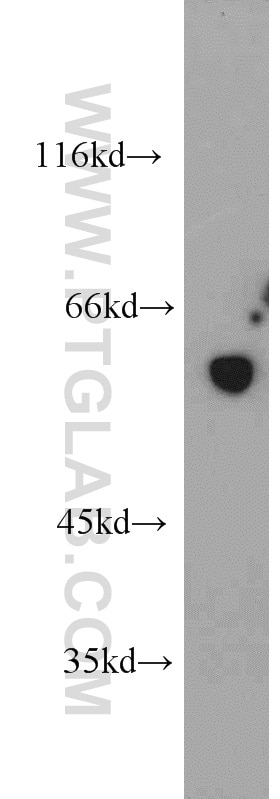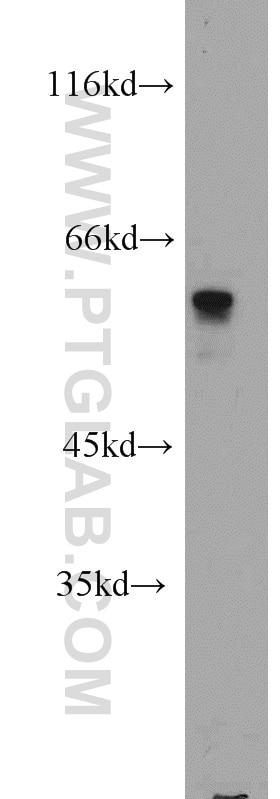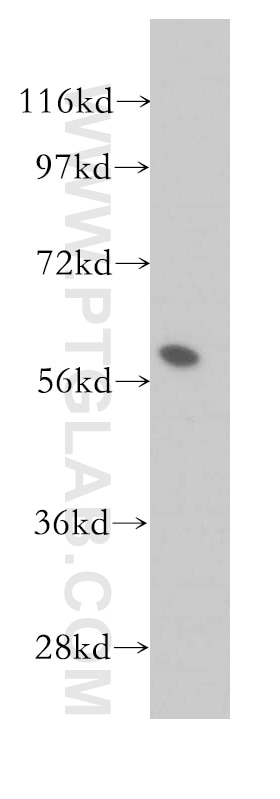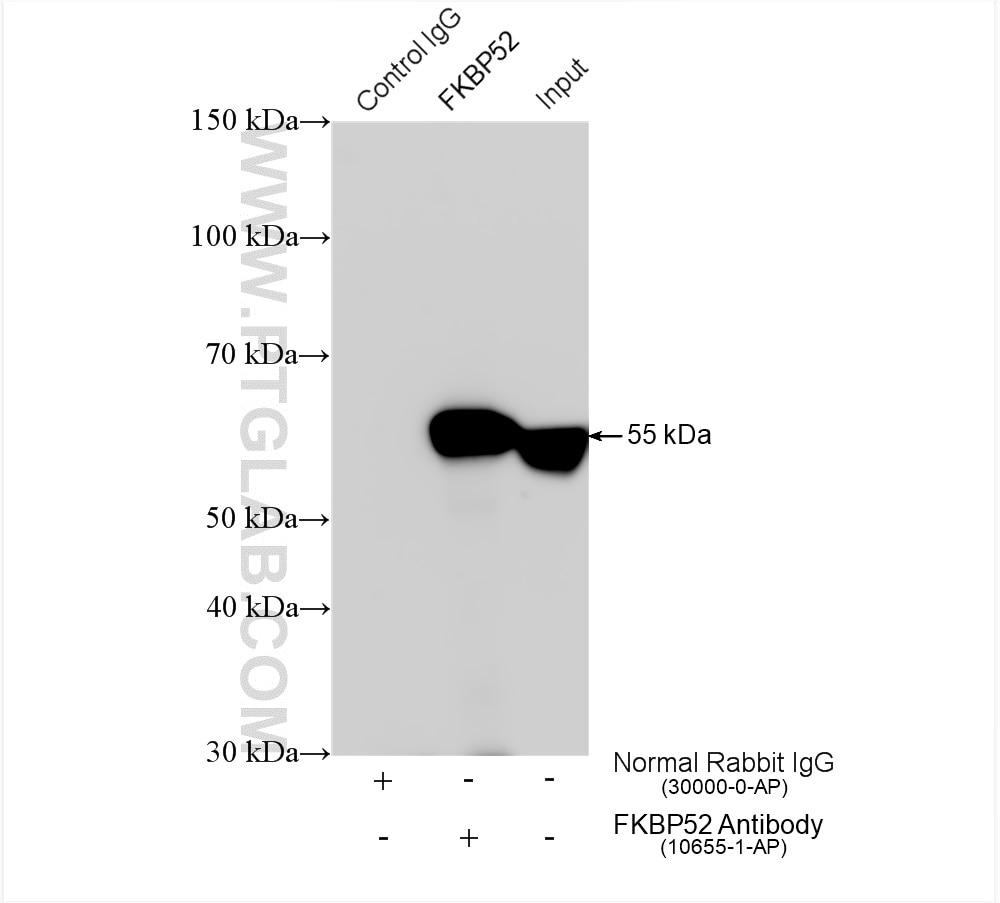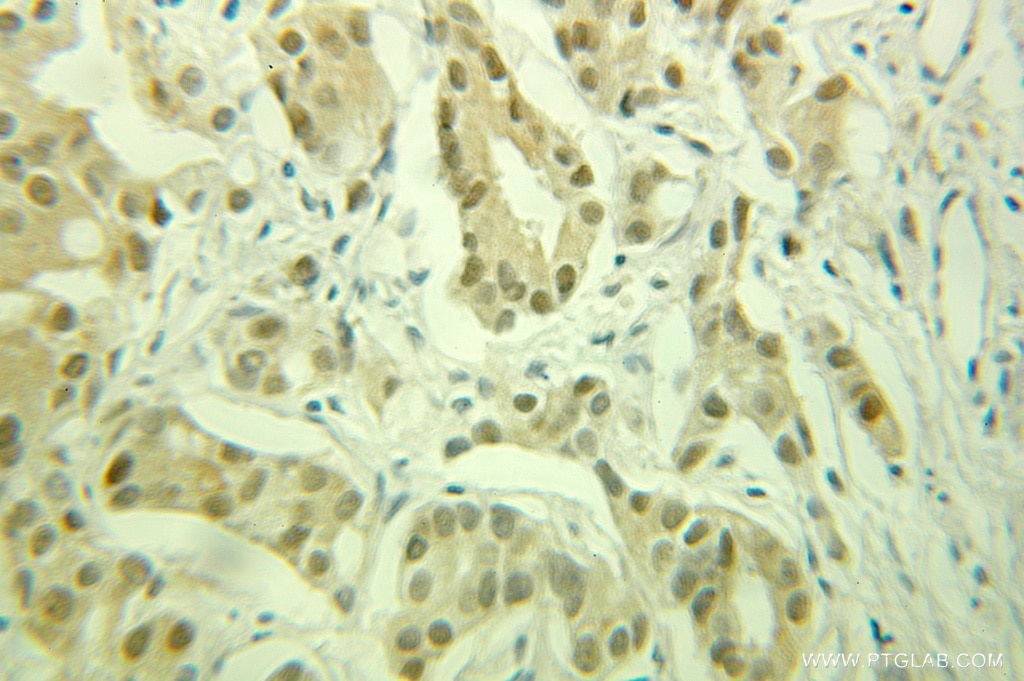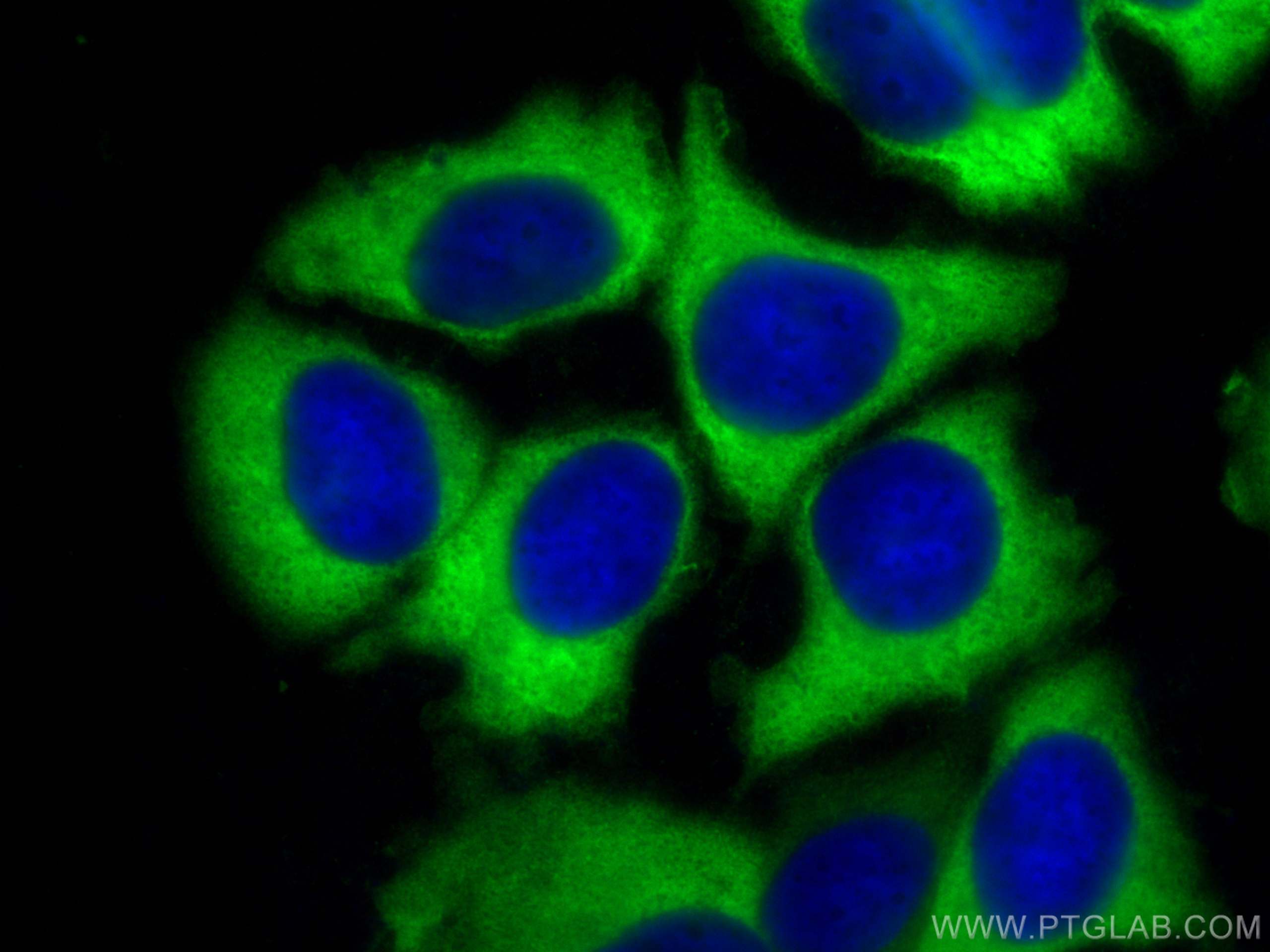- Phare
- Validé par KD/KO
Anticorps Polyclonal de lapin anti-FKBP52
FKBP52 Polyclonal Antibody for WB, IHC, IF/ICC, IP, ELISA
Hôte / Isotype
Lapin / IgG
Réactivité testée
Humain, rat, souris et plus (1)
Applications
WB, IHC, IF/ICC, IP, ELISA
Conjugaison
Non conjugué
N° de cat : 10655-1-AP
Synonymes
Galerie de données de validation
Applications testées
| Résultats positifs en WB | cellules HeLa, cellules C6, cellules HSC-T6, cellules Jurkat, cellules MCF-7, cellules NIH/3T3, cellules PC-3, tissu testiculaire de rat |
| Résultats positifs en IP | cellules HeLa, |
| Résultats positifs en IHC | tissu de cancer de la prostate humain il est suggéré de démasquer l'antigène avec un tampon de TE buffer pH 9.0; (*) À défaut, 'le démasquage de l'antigène peut être 'effectué avec un tampon citrate pH 6,0. |
| Résultats positifs en IF/ICC | cellules MCF-7, |
Dilution recommandée
| Application | Dilution |
|---|---|
| Western Blot (WB) | WB : 1:1000-1:8000 |
| Immunoprécipitation (IP) | IP : 0.5-4.0 ug for 1.0-3.0 mg of total protein lysate |
| Immunohistochimie (IHC) | IHC : 1:20-1:200 |
| Immunofluorescence (IF)/ICC | IF/ICC : 1:50-1:500 |
| It is recommended that this reagent should be titrated in each testing system to obtain optimal results. | |
| Sample-dependent, check data in validation data gallery | |
Applications publiées
| KD/KO | See 5 publications below |
| WB | See 14 publications below |
| IHC | See 4 publications below |
| IP | See 1 publications below |
Informations sur le produit
10655-1-AP cible FKBP52 dans les applications de WB, IHC, IF/ICC, IP, ELISA et montre une réactivité avec des échantillons Humain, rat, souris
| Réactivité | Humain, rat, souris |
| Réactivité citée | rat, Humain, poulet, souris |
| Hôte / Isotype | Lapin / IgG |
| Clonalité | Polyclonal |
| Type | Anticorps |
| Immunogène | FKBP52 Protéine recombinante Ag1019 |
| Nom complet | FK506 binding protein 4, 59kDa |
| Masse moléculaire calculée | 52 kDa |
| Poids moléculaire observé | 52 kDa |
| Numéro d’acquisition GenBank | BC007924 |
| Symbole du gène | FKBP52 |
| Identification du gène (NCBI) | 2288 |
| Conjugaison | Non conjugué |
| Forme | Liquide |
| Méthode de purification | Purification par affinité contre l'antigène |
| Tampon de stockage | PBS avec azoture de sodium à 0,02 % et glycérol à 50 % pH 7,3 |
| Conditions de stockage | Stocker à -20°C. Stable pendant un an après l'expédition. L'aliquotage n'est pas nécessaire pour le stockage à -20oC Les 20ul contiennent 0,1% de BSA. |
Informations générales
FKBP52 (FK506 binding protein 4) is a member of the immunophilin protein family that comprises intracellular protein effectors of immunosuppressive drugs, and it is known as a steroid receptor-associated protein. As a novel regulator of microtubule dynamics, FKBP52 is associated with the motor protein dynein and with the cytoskeleton during mitosis. FKBP52 is highly expressed in CNS regions susceptible to Alzheimer's, and plays a role in modulating toxicity of Abeta peptides. The protein can associate with the Tau function, and may help to decipher and modulate the events involved in Tau-induced neurodegeneration. In addition, FKBP52 is likely to play a role in growth and development of the male genitalia.
Protocole
| Product Specific Protocols | |
|---|---|
| WB protocol for FKBP52 antibody 10655-1-AP | Download protocol |
| IHC protocol for FKBP52 antibody 10655-1-AP | Download protocol |
| IF protocol for FKBP52 antibody 10655-1-AP | Download protocol |
| IP protocol for FKBP52 antibody 10655-1-AP | Download protocol |
| Standard Protocols | |
|---|---|
| Click here to view our Standard Protocols |
Publications
| Species | Application | Title |
|---|---|---|
Theranostics FKBP4 connects mTORC2 and PI3K to activate the PDK1/Akt-dependent cell proliferation signaling in breast cancer.
| ||
Clin Cancer Res Identification of a new panel of serum autoantibodies associated with the presence of in situ carcinoma of the breast in younger women. | ||
Mol Oncol FKBP51 and FKBP52 regulate androgen receptor dimerization and proliferation in prostate cancer cells.
| ||
Int J Mol Sci Secretome Analyses Identify FKBP4 as a GBA1-Associated Protein in CSF and iPS Cells from Parkinson's Disease Patients with GBA1 Mutations | ||
J Cell Physiol Multiple roles for peptidylglycine α-amidating monooxygenase in the response to hypoxia. | ||
RNA The co-chaperones Fkbp4/5 control Argonaute2 expression and facilitate RISC assembly.
|
